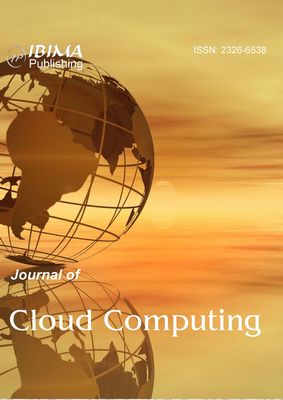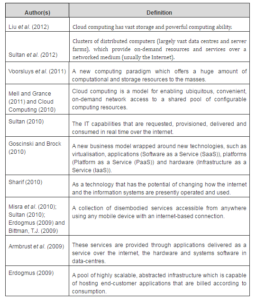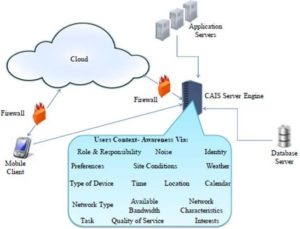Acar, E., Kocak I., Sey, Y. & Arditi, D. (2005). “Use of Information and Communication Technologies by Small and Mediumsized Enterprises (SMEs) in Building Construction,” Construction Management and Economics, 23 (7), 713-722.
Publisher – Google Scholar – British Library Direct
Anumba, C. J., Pan, J., Issa, R. R. & Mutis, I. (2008). “Collaborative Project Information Management in a Semantic Web Environment. Engineering,” Construction and Architectural Management, 15 (1), 78-94.
Publisher – Google Scholar – British Library Direct
Armbrust, M., Fox, A., Griffith, R., Joseph, A. D., Katz, R. H., Konwinski, A., Lee, G., Patterson, D. A., Rabkin, A., Stoica, I. & Zaharia, M. (2009). “Above the Clouds: A Berkeley View of Cloud Computing,” Technical Report UCB/EECS-2009-28, EECS Department, University of California, Berkeley, [Online], [Retrieved May 2, 2012],
http://www.eecs.berkeley.edu/Pubs/TechRpts/2009/EECS-2009-28.pdf.
Publisher
Aziz, Z., Anumba, C. J., Ruikar, D., Carrillo, P. & Bouchlaghem, D. (2006). “Intelligent Wireless Web Services for Construction: A Review of the Enabling Technologies,” Automation in Construction, 15 (2), 113-123.
Publisher – Google Scholar
Aziz, Z., Anumba, C. & Peña-mora, F. (2009). “A Road-Map to Personalized Context-Aware Services Delivery in Construction,” ITcon, Special Issue Next Generation Construction IT: Technology Foresight, Future Studies, Roadmapping, and Scenario Planning , 14, 461-472, [Online], [Retrieved May 2, 2012],
http://www.itcon.org/cgi-bin/works/Show?2009_30.
Publisher
Barthelmess, P. (2003). “Collaboration and Coordination in Process-Centered Software Development Environments: A Review of the Literature,” Information and Software Technology, 45 (13), 911-928.
Publisher – Google Scholar
Bittman, T. (2009). “Cloud Computing Inquiries at Gartner,” [Online], [Retrieved May 2, 2012]
http://blogs.gartner.com/thomas_bittman/2009/10/29/cloud-computing-inquiries-at-gartner/.
Publisher
Cloud Computing. (2010). “Cloud Computing Use Cases,” A White Paper Produced by the Cloud Computing Use Case Discussion Group, Version 4.0, [Online], [Retrieved May 2, 2012],
http://opencloudmanifesto.org/Cloud_Computing_Use_Cases_Whitepaper-4_0.pdf.
Publisher
Erdogmus, H. (2009). “Cloud Computing: Does Nirvana Hide Behind the Nebula?,” IEEE Software, 26 (2), 4-6.
Publisher – Google Scholar
Fathi, M. S., Anumba, C. J. & Carrillo, P. (2009). “Real-Time Mobile Information System for Construction Programme Management,” Proceedings of the 2nd Construction Industry Research Achievement International Conference(CIRAIC2009), Kuala Lumpur, Malaysia.
Publisher – Google Scholar
Foley, J. (2008). “Private Clouds Take Shape,” InformationWeek, August 9, [Online], [Retrieved May 2, 2012],http://www.informationweek.com/news/services/business/209904474.
Publisher
Garza., J. M. & Howitt, I. (1998). “Wireless Communication and Computing at the Construction Site,” Automation in Construction, 7 (4), 327-347.
Publisher – Google Scholar
Goscinski, A. & Brock, M. (2010). “Toward Dynamic and Attribute Based Publication, Discovery and Selection for Cloud Computing,” Future Generation Computer Systems, 26 (7), 947-970.
Publisher – Google Scholar
Hoover, J. N. & Martin, R. (2008). ‘Demystifying the Cloud,’ InformationWeek Research & Reports, June, 30-37.
Google Scholar
Kim, W. (2009). “Cloud Computing: Today and Tomorrow,” Journal of Object Technology, 8 (1), 65-72, [Online], [Retrieved May 2, 2012], http://jot.fm/issues/issue_2009_01/column4/.
Publisher
Kondratova, I. (2003). ‘Voice and Multimodal Access to AEC Project Information,’ The 10th ISPE International Conference on Concurrent Engineering: The Vision for Future Generations in Research and Applications. J. Cha et al, (eds), Swets & Zeitlinger. Lisse, Portugal, July 26-30, 755-760, NRC 45829.
Google Scholar
Lang, S. Y. T., Dickinson, J. & Bucha, R. O. (2002). “Cognitive Factors in Design,” Computers in Industry, 48, 89-98.
Publisher – Google Scholar
Leung, S.- W., Mak, S. & Lee, B. L. P. (2008). “Using a Real-Time Integrated Communication System to Monitor the Progress of Quality of Construction Works,” Automation in construction, 17 (6), 749-757.
Publisher – Google Scholar
Liu, L. X., Hu, G., Huang, Z. & Peng, Y. X. (2012). “White Cloud or Black Cloud: Opportunity and Challenge of Spectrum Sharing on Cloud Computing,” Advanced Materials Research, 430-432 (1), 1290-1293.
Publisher – Google Scholar
Mell, P. & Grance. T. (2011). “The NIST Deï¬nition of Cloud Computing,” National Institute of Standards and Technology, Special Publication 800-145.
Publisher
Milosevic, D. Z. (2003). Project Management ToolBox: Tools and Techniques for the Practicing Project Manager, New Jersey: John Wiley & Sons, 584.
Publisher – Google Scholar
Misra, S. C. & Mondal, A. (2010). “Identification of a Company’s Suitability for the Adoption of Cloud Computing and Modelling its Corresponding Return on Investment,” Mathematical and Computer Modelling, 53 (3-4), 504-521.
Publisher – Google Scholar
O’Brien, W. J., Hurley, M. J., Solis, F. A. M. & Nguyen, T. (2011). “Cognitive Task Analysis of Superintendent’s Work: Case Study and Critique of Supporting Information Technologies,” Journal of Information Technology in Construction(ITcon), 16, 529-556.
Publisher
Omar, B. & Ballal, T. (2009). “Intelligent Wireless Web Services: Context-Aware Computing in Construction-Logistics Supply Chain,” ITcon, Special Issue Next Generation Construction IT: Technology Foresight, Future Studies, Roadmapping, and Scenario Planning , 14, 289-308, [Online], [Retrieved May 2, 2012],
http://www.itcon.org/cgi-bin/works/Show?2009_20.
Publisher
Peansupap, V. & Walker, D. H. T. (2006). “Information Communication Technology (ICT) Implementation Constraints: A Construction Industry Perspective,” Engineering, Construction and Architectural Management, 13 (4), 364-379.
Publisher – Google Scholar – British Library Direct
Reeves, D. (2009). “Cloud Computing Transforming IT,” Burton Group publication, Utah U.S.A 84047-4169, [Online], [Retrieved May 2, 2012], http://net.educause.edu/ir/library/pdf/ECR0901.pdf.
Publisher
Sharif, A. M. (2010). “It’s Written in the Cloud: The Hype and Promise of Cloud Computing,” Journal of Enterprise Information Management, 23 (2), 131-134.
Publisher – Google Scholar
Sultan, N. (2010). “Cloud Computing for Education: A New Dawn?,” International Journal of Information Management, 30 (2), 109-116.
Publisher – Google Scholar
Sultan, N. & Bunt-Kokhuis, S. V. D. (2012). “Organisational Culture and Cloud Computing: Coping with a Disruptive Innovation,” Technology Analysis & Strategic Management, 24 (2), 167-179.
Publisher – Google Scholar
Thomas, P. Y. (2011). ” Cloud Computing: A Potential Paradigm for Practicing the Scholarship of Teaching and Learning,” The Electronic Library, 29 (2), 214-224.
Publisher – Google Scholar
Voorsluys, W., Broberg, J. & Buyya, R. (2011). “Introduction to Cloud Computing,” Cloud Computing: Principles and Paradigms, John Wiley and Sons, 1-41.
Publisher – Google Scholar
Zhang, X., Kunjithapatham, A., Jeong, S. & Gibbs, S. (2011). “Towards an Elastic Application Model for Augmenting the Computing Capabilities of Mobile Devices with Cloud Computing,” Mobile Networks and Applications, 16 (3), 270-284.
Publisher – Google Scholar
Zhang, X. & Liu, Y. (2007). “The Impact of ICT on Supplier-Buyer Relationship in Different Types of Supply Chain,”Proceedings of 3rd international conference on wireless communications, Beijing, China, 4689-4692.
Publisher – Google Scholar





